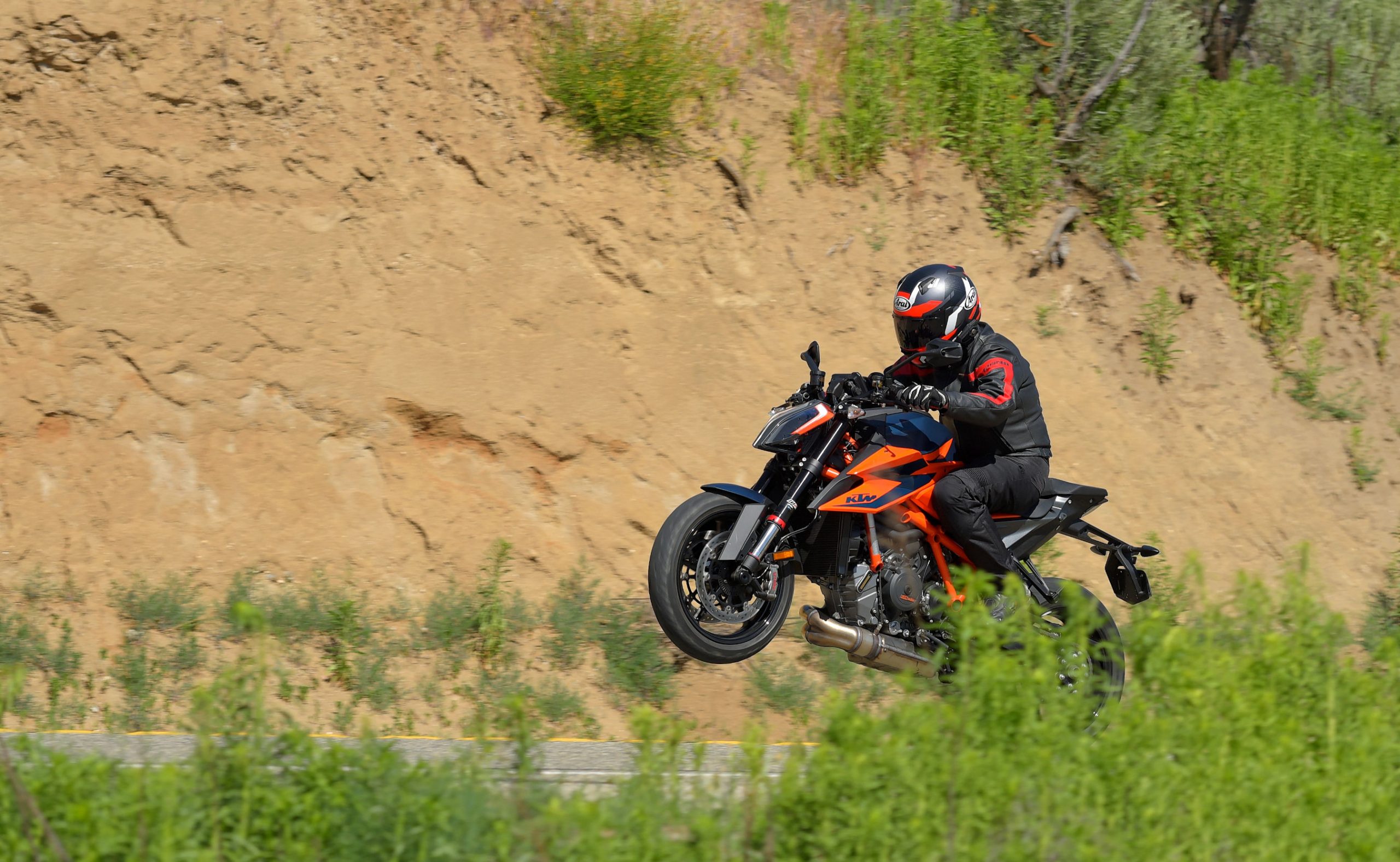
We briefly described the riding experience provided by the 2020 KTM 1290 Super Duke R in Part 1 of this review. This bike is fast with a capital “F”, but, in some ways, more usable than four-cylinder super-nakeds that make most of their power much further up the rpm range.
As the third iteration of the 1290 Super Duke R that debuted in 2014, KTM designers and engineers had the task of improving an already outstanding super naked. The goal, according to KTM, boiled down to three aspects, including “shed as much weight as possible (in total six kilograms), boost useable power where applicable (2 hp increase with the same torque character) and provide a heightened sense of finesse through the rider’s hands (a new chassis and latest spec electronics).”
Before we talk more about the engine and electronics, let’s discuss the frame and the chassis, as a whole. KTM focused a lot of attention here. The new bike feels stiffer and more responsive.
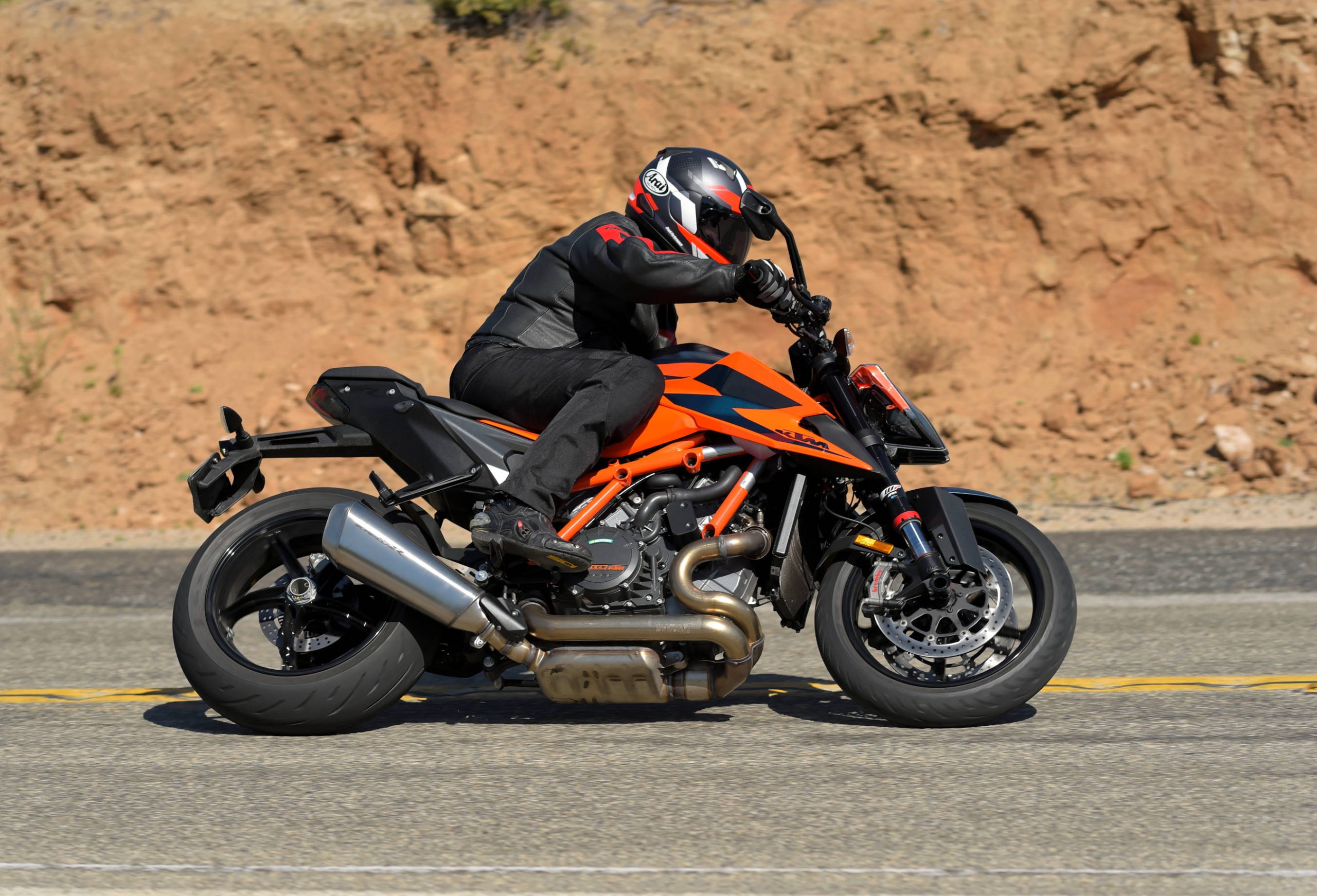
With the engine as a stressed member of the frame, and the steel trellis featuring larger diameter tubing, KTM claims triple the torsional stiffness of the prior model, and a lower center of gravity. All this while reducing the weight of the frame. The stiffer swingarm is the same length, but the pivot point has been raised 5 mm to reduce squat under acceleration. The triple clamps, steering column and subframe were all redesigned, and all lose weight, as well.
WP, a sister company of KTM, provides new suspension for the Super Duke R this year. The APEX fork splits compression and rebound between its two legs, and is fully adjustable for compression, rebound and spring preload. It is a beefy 48 mm upside-down design, so forget about fork flex.
The WP APEX shock is also new this year, fully adjustable and 200 grams lighter. Shock preload can be adjusted manually, without tools. Just reach down and dial in the amount you choose.
Big, 320 mm floating discs are squeezed by, arguably, the best brake calipers available from Brembo for street use. Once again, the brake system is lighter this year, in addition to being more powerful and efficient. The brakes slow down new, lighter wheels shod with Bridgestone’s superb S22 rubber.
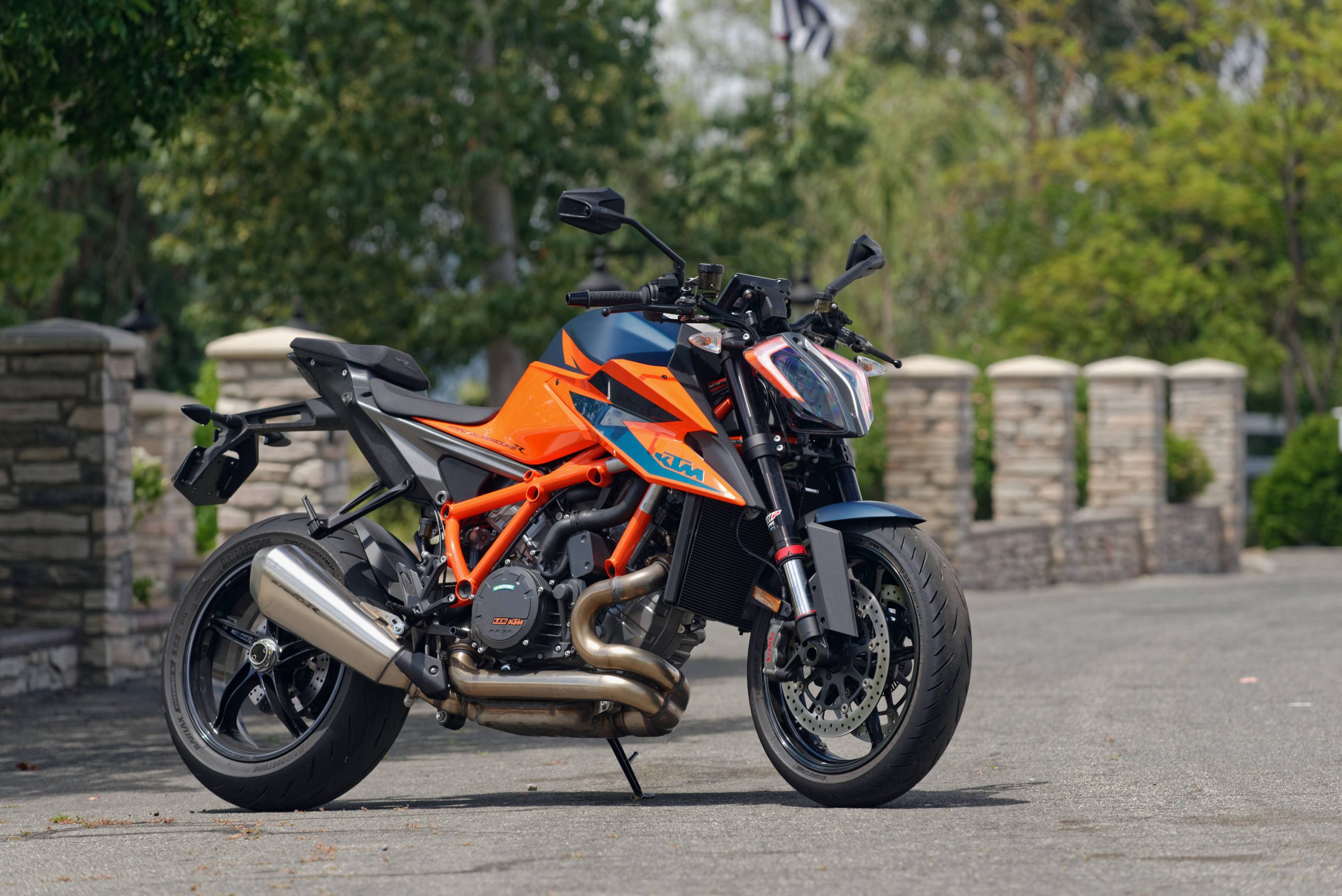
The design and the aesthetics, as well as the ergonomics, reflect a focus on minimalism. Engine and everything else necessary to contribute to the riding experience … and nothing more. Working again with KISKA Design, the extreme angularity now creates a family resemblance for all KTMs, it seems. But standing next to the 1290 Super Duke R after an invigorating blast through the canyons, we are struck by how compact, and dense the design is.
The riding experience reflects this. If “too much horsepower” was a characteristic of previous models, it is now, perhaps, a hallmark. Limited only by the skill of the rider (and for many riders, these limits are severe), the Super Duke R can accelerate, brake and turn near the limits of your imagination.
Which brings us back to the engine, and those advanced electronics that tame it. Each of the two cylinders is slightly more than 650cc in displacement (for a total of 1,301cc). As a youngster, a 650cc dirt bike was, in some ways, the ultimate. Wheelies whenever you felt like it, and power slides to suit any occasion. In theory, the two 650s beating beneath the seat of the Super Duke R provide similar possibilities on tarmac.
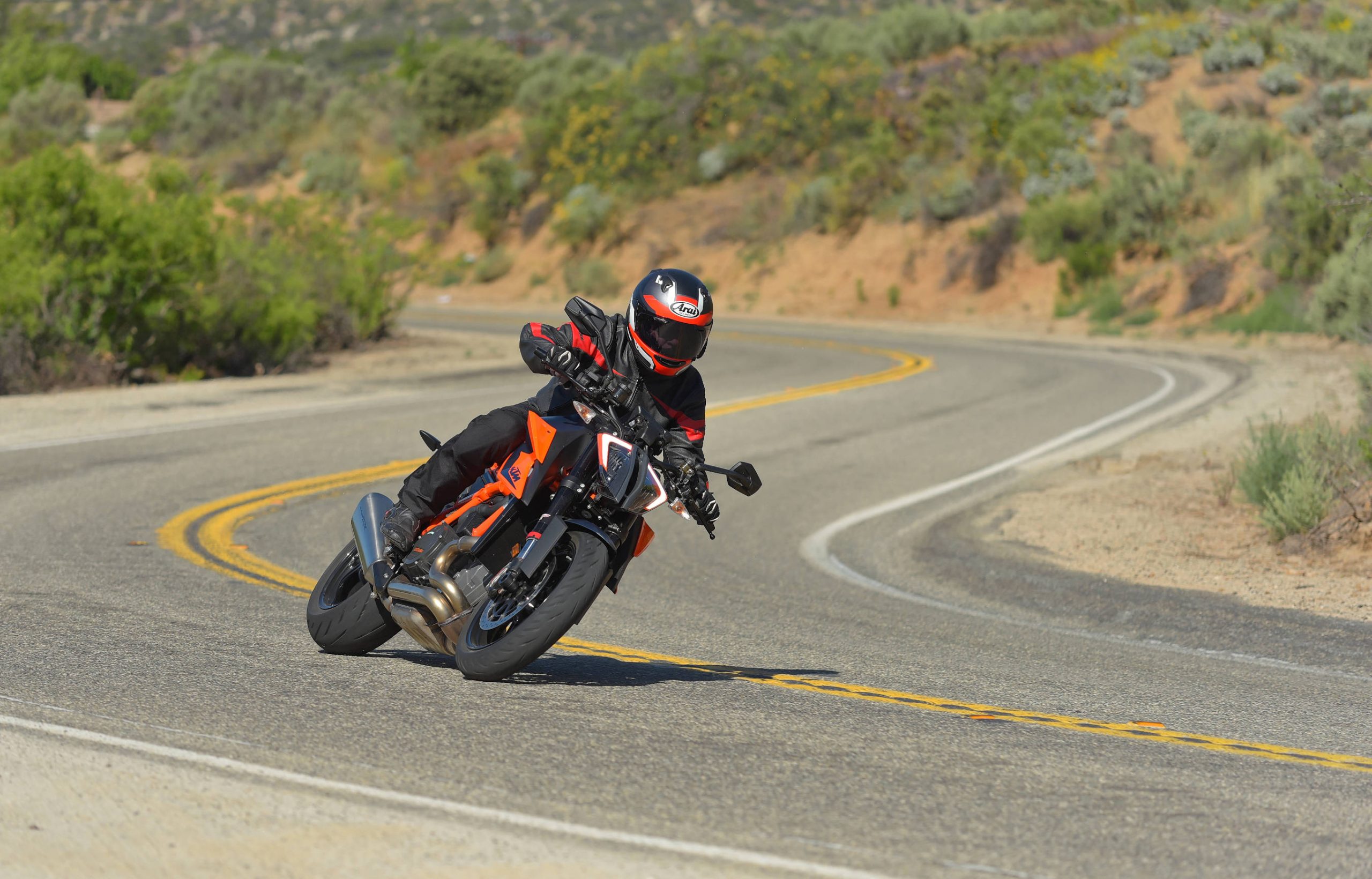
The electronics try to control all this beastly power. At this point, KTM has lots of experience with electronic rider aids, and generational development has refined those aids. Ride modes may be familiar, including Rain, Street, Sport, Track and an optional Performance mode … but they have all been tweaked, and enhanced for the new model. The goal is to make them effective, but effectively invisible to the rider.
While Rain softens throttle response and limits peak horsepower, Street is for “everyday use” with full horsepower and a reasonable throttle response, together with mid-level traction control and wheelie control that keeps the front contact patch just a few inches off the ground under hard acceleration. Sport mode is what we used the most after becoming familiar with the bike.
Sport mode sharpens throttle response without making it “touchy”. Power delivery is still linear and controllable, but sharper at the same time. The front wheel can come up a bit further under acceleration, and TC allows “slight wheel spin” rather than none at all. Track mode allows the rider to customize throttle response, TC and wheelie control. Wheelie control can be shut off, and the amount of wheel spin permitted can be set to one of nine separate levels. The optional Performance mode is similar to Track mode, but allows access to KTM’s “My Ride” smartphone integration.
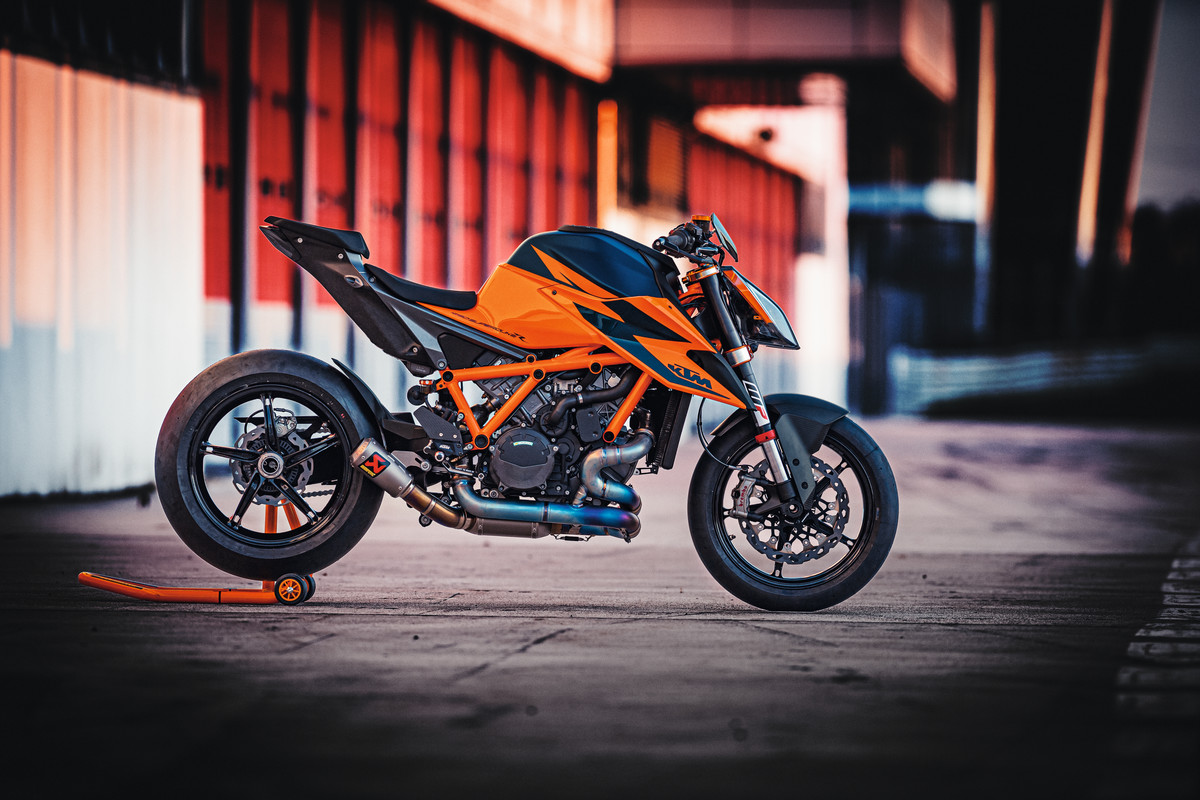
The Super Duke R continues to feature intuitive handlebar controls that allow the rider to access and control menu items from the left grip. Cruise control is also available. Those menu items appear on a bright TFT menu display.
A sophisticated six-axis IMU is constantly feeding information to the wheel slip control and the ABS systems. The result, according to KTM, is both extremely quick response to changing riding conditions and an almost seamless, invisible intervention from the rider’s perspective.
The 1290 Super Duke R also features KTM’s QuickShifter+. This allows clutchless upshifts and downshifts, with rev-matching.
The handlebar is adjustable into four positions. Together with new seat and gas tank shape, KTM tries to strike the perfect balance between a performance position for the rider and everyday comfort.
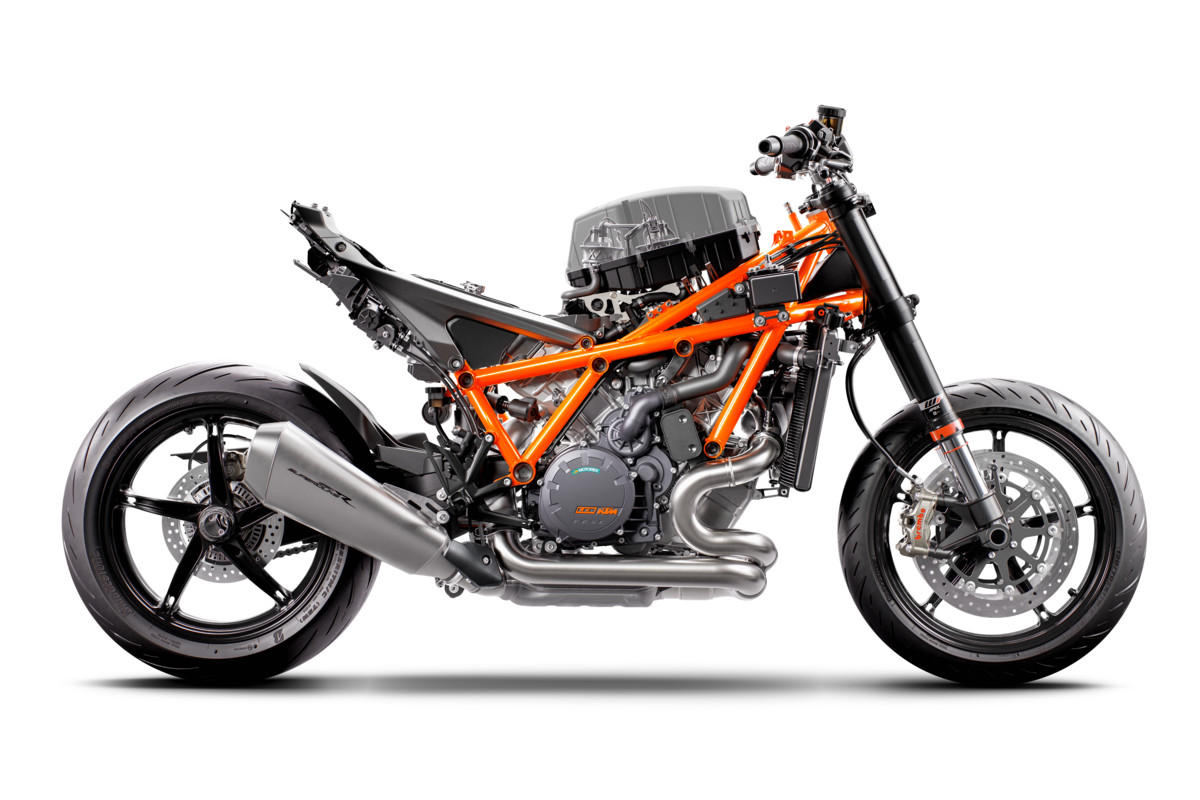
Riding the Super Duke R can be a remarkable experience. At relatively low rpm levels, and light throttle application, it is a docile, reasonably comfortable machine that can be enjoyed by riders of just about every skill level. The torque and the big power pulses thrown off by the v-twin can put a smile on the rider’s face without trying to be a hero.
At the same time, if one is so inclined (and capably skilled), apply the throttle hard and let the bike rev freely above 7,000 rpm … but hold on tight. Forget first and second gear for a minute, acceleration in third gear above 7,000 rpm is wicked and requires acclimatization.
Find a familiar twisty road, and you might be able to ride it in a single gear. Leaving the bike in third gear on a moderately tight canyon climb, for instance, allowed corner exits at as little as 15 mph and corner entries (before braking) at 100 mph+. Never changing gear. Try that on a high-strung four-cylinder … and, no, those slow corner exits were not lethargic as the 1,301cc twin quickly jumps into the meat of its torque curve.
The brakes seem nearly as accomplished as the engine, offering huge power and excellent feel. The chassis remains composed, and planted with the suspension offering plenty of adjustability between street comfort and a buttoned-down track attitude. Stiction is low at both ends, and the suspension as a whole has a high quality feel.
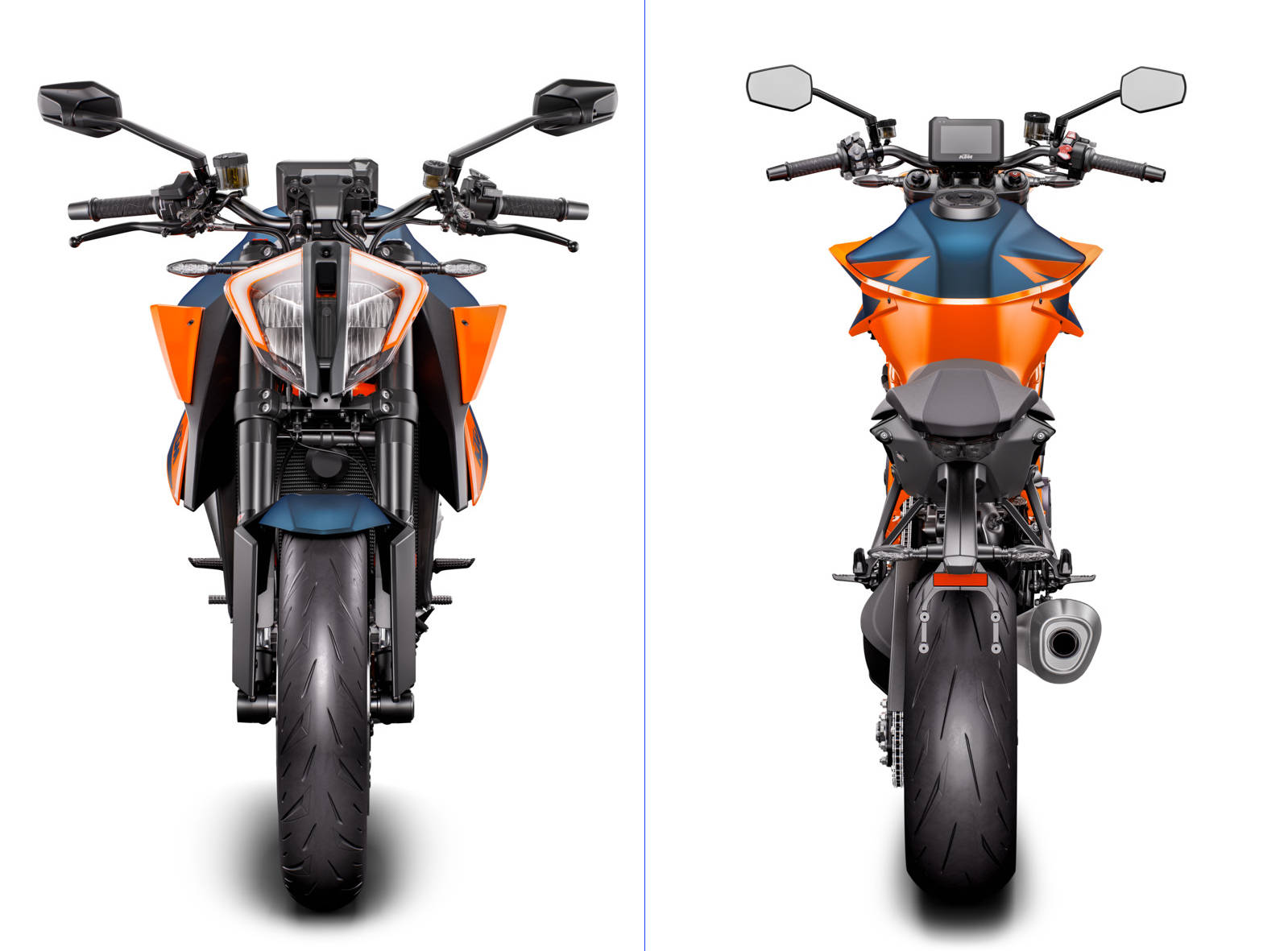
The QuickShifter+ system seems to work better than it has on some earlier models with this feature, but several manufacturers offer excellent quickshifters at this point, and the KTM is no longer a standout in this category. Shifts are positive, but not quite as seamless as some of the current competition.
The Super Duke R changes directions easily, and big lean angles do not sap confidence from the rider, undoubtedly attributable to the chassis and the fine tires. This bike is hardly a one-trick pony. It inhales straightaways with astonishing pace, it hauls itself down quickly and then confidently carves an arc through the apex.
Which means the 1290 Super Duke R would be right at home on a race track. A skilled rider doesn’t need a fairing (“look at that cute little 600 over there with the XYZ Team graphics!”), as a skilled track day rider/racer could easily dispatch lesser machines (provided he could handle the wind blast on the straightaways).
Ironically, this ability to excel at performance riding is, perhaps, the main quality that limits the appeal of the KTM 1290 Super Duke R. Most mortals will simultaneously marvel at the capabilities of the machine while feeling totally inadequate as a pilot of it. The capabilities of the KTM Super Duke R are far beyond the abilities of most riders to exploit them, and those riders will be well aware of this fact.
But that remarkable engine allows those same mortals to short-shift their way to a thrilling street ride that will still eclipse the best efforts of equal riders that need more than 9,000 rpm before the “party starts” on their four-cylinder machines. The aforementioned third-gear romp through the twisties was a blast, which exercised our adrenal glands and allowed exploration of limited traction situations with total control.
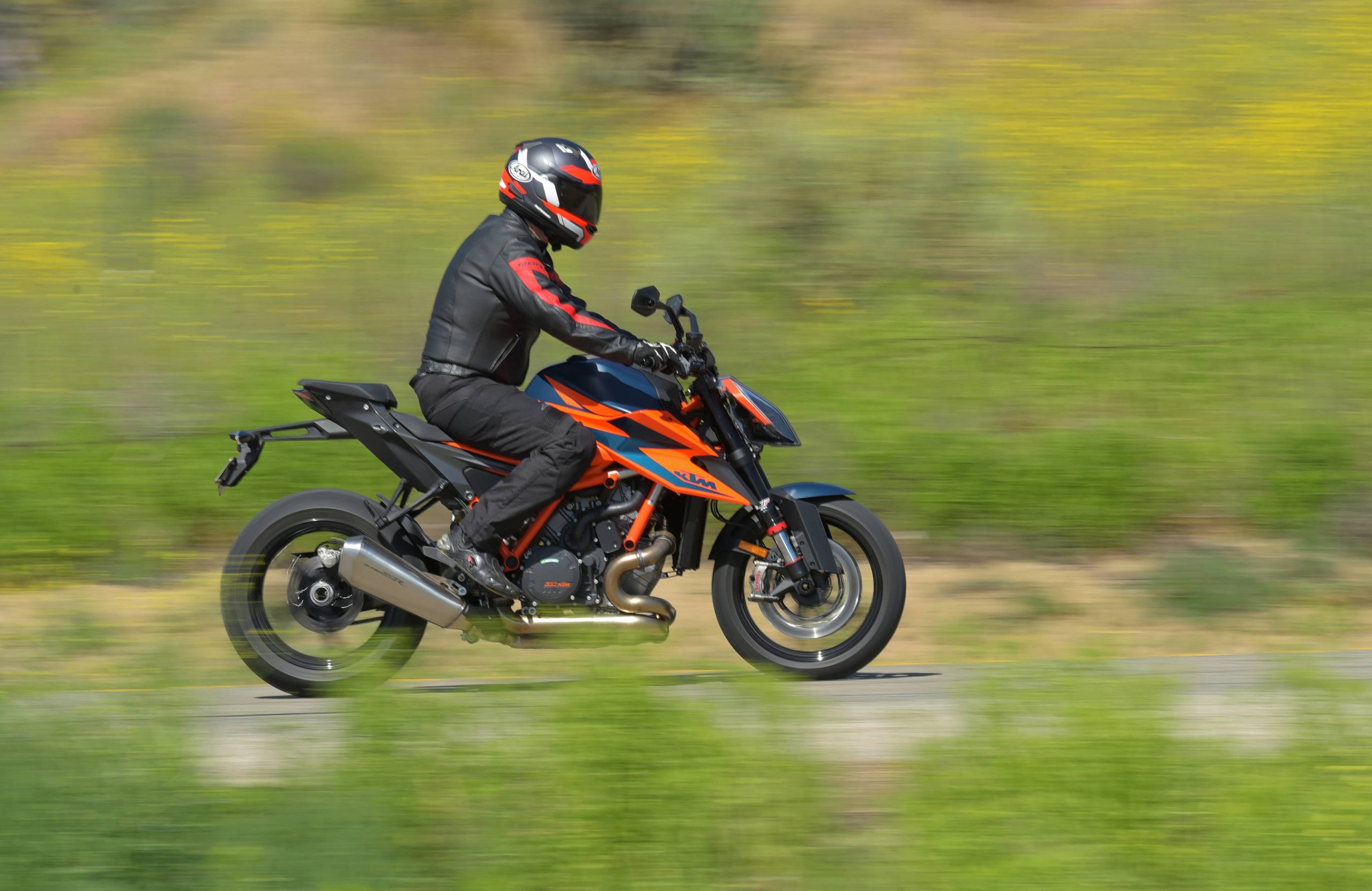
So in the end, it was the torque that won us over. Generous acceleration is always available, even below the mind-blowing acceleration offered above 7,500 rpm. The v-twin also feels, and sounds, good – providing an intangible component to riding enjoyment.
For a naked bike, the ergonomics are a tad aggressive. Relatively low, forward handlebars and high-ish foot pegs don’t leave the rider fantasizing about extended tours on the Super Duke R. It’s not built for that, but would nevertheless provide a relatively comfortable mount for commuting and weekend fun. The 4.2 gallon fuel tank has the thirsty KTM looking for a fuel stop every 130 miles, or so.
The 2020 KTM Super Duke R carries a U.S. MSRP of $18,699. Take a look at KTM’s web site for additional details, specifications, available accessories and color schemes.






I had a ’14 and currently own a ’17 Super Duke R. These are great real world performance bikes. I’m in my late 40s and 6’3 tall, and I find them quite comfortable, even on longer day rides. The ’20 looks like a nice step forward overall, but the smaller fuel capacity and higher pegs are enough to keep me on my Gen 2 bike. But a Super Duke GT based on the ’20 might convince me to upgrade. Give me a 6 gallon tank and slightly lower pegs, and I’d probably scratch the check.
I’ve not ridden this third gen Beast, but regarding my second gen: I’ve often described the bike as capable of riding like one rides in a dream. Limitations, even seemingly physics, fade.
Dirk’s line, “the Super Duke R can accelerate, brake and turn near the limits of your imagination.” resonates.
When my ’14 doesn’t scare me I’ll buy the ’20. I don’t think that will happen any time soon.
It looks way better with the bodywork off.
It’s a hell of a bike, for sure.
More bike than I need, or even want, really.
In fairness to the KTM, all modern naked superbikes are ugly. I’d prefer a revamped RC8 but I wouldn’t kick the superduke out of bed.
Funny how 99% of the negative comments come from people who have never owned one or ridden one.
You don’t have to marry a girl to find her unattractive.
99% of comments, positive or negative, about any bike are going to come from people who don’t own that particular bike. Nothing wrong or abnormal about that.
You have an odd sense of humour.
Why do KTMs have to be so ugly? Like the bikes, but can’t stand to look at them.
That name is too funny 😆 BM
I’m not a fan of the current trend toward turnicated tail sections. But it does have a bolt on tail section. Tail section, seat, fender or whatever of your choice…
The overly IMO stylized dirt bike proportions would have to try to grow on me for a while. You could always get a metal guy to make an aluminium tank to cover that huge airbox and a couple of radiator shrouds that are more pleasing to your eye. The naked photo above does seem to indicate a bike with nice bones.
The aluminium tank for my current street bike uses radiator shrouds from different bike to radically change the look of the resulting rig.
But you can get away with things like that when you start with a dirt bike. Street bikes all have parts made on separate planets by people who never ever communicate with one another.
If you have a look at the frame below the seat, and view it from the side on, take the 2 triangles as the inspiration for the headlights.
Once I saw this, my view changed from its plainly weirdo, to having a designed visual connection.
This is like reading a new model write up thirty years ago. The chassis got three times stiffer and lighter. They moved the swing arm pivot. Brakes and wheels are improved and lightened. Suspension forks increased in diameter. The whole bike loses six kilos.
And so far nobody mentioned the need for luggage, a much larger gas tank, a center stand, flower boxes… And while it was hinted at, nobody actually used the word origami.
Is that Wang Chung I hear on the radio?
You must not own one.
No. My personal street bike is a modified XR650R supermoto that weighs well under 300 pounds. And you can have my supermoto when you pry my cold dead hands…
It’s kick start only, and you can ride it if you can start it.
Really now though. It has been a long time since a street bike received a large dose of refinements and lost a bunch of weight at the same time.
It has also been quite a while since the folks here respected a bike enough for what it is and not to try to turn it into another Gold Wing replacement.
Great apples to paper clips comparison 👍….
I also own the latest generation KTM Super Duke GT, the more comfortable version of this bike. Yes, the GT is slightly heavier, but otherwise it’s more practical, with higher handlebars, lower pegs, and panniers standard. I come nowhere near the limits of the GT, and would find the limits of this bike even more unreachable. After a ride on the KTM SDGT, I’m left scratching my head as to why I have other bikes sharing the garage…the KTM is an incredible do it all machine. Read Dirck’s review of the 2019 KTM SDGT and compare with this review.
“Slightly heavier”. Is that a bad thing?
Triple the torsional stiffness??? The prior model must have used linguini for its frame.
I have the 1290 Super Duke GT version of this bike. It has, I think, most of the capability of the Super Duke R usable by the average rider . Having excellent suspension and power reserve combined with all day comfort in a relatively light weight, easy to ride bike makes the price justifiable. Used SDGT’s are out there at affordable prices. Try one, you can thank me later.
Why would anyone buy a Ducati Monster over this bike?
Same reason as they’d buy any other bike over this one. They like it better.
One good reason to prefer the Ducati Monster over this KTM is the ugly Kiska design elements. The “lightning bolt” or “shield” bodywork is just awful.
So I very much like Ducati and owned a 2001 Monster 900 with Ohlins suspension. Enjoyed the heck out of that thing. But I would prefer this over a current, comparable Monster. And I don’t think it looks ugly. To each his own.
If a Mondoshawan had a son, it would look like a Super Duke.
“Super Green”
That headlight does look like the face of those beings in that movie lol.
Love everything about it including the looks. Consider it a bargain too.
Modern KTM’s are love/hate motorcycles. You either love them or hate them. If the styling department decides to hire a designer that owns a French curve instead of just a straight edge, they might find their sales would increase ten-fold. Until then I see a rather limited market for these bikes. Talk about a company hobbling themselves.
Agree 100%.
Ditto
Man I buy one if it wasn’t so UGLY
Why is their a failure to make the point that a 4 cylinder with the same displacement with the optimized cam profiles will deliver a similar experience. 300cc greater displacement than the 4’s is not a good comparison. Always hoping someone will build bigger displacement 4’s to compete with this bike rather than the screamers such as the Tuono.
The Tuono has more of a howl than a scream. And that sound is a ‘feature’ not a bug. 🙂
Why the comparisons with 600cc four cylinder bikes? On those, the problem isn’t such a big deal since 9,000 rpm comes up in a few milliseconds. It is frustrating to ride behind people that do 100mph in the straights just to crawl around corners at 15. My 690 Duke prefers to keep corner speeds up so there’s not as much need for massive power to catch back up again. I’m sure it’s a fine machine but such a waste on 99.99% of the riding population.
There is a flavor of motorcycle for everyone. From the Honda SuperCub to the Boss Hoss. Somewhere around the fringe of naked bike motorcycling this bike is closer to a Boss Hoss than the SuperCub in both styling and power. Pure excess with a twist of livability. Much like a Boss Hoss, I’d like to ride one once to see what it is like. But like the Boss Hoss, it just seems so over the top. Still I’m glad both exist and people enjoy them. I’m waiting for this KTM styling to change to something a bit less in your face. (Hello Husky?)
Yessss. A Vitpilen 1301!
“Leaving the bike in third gear on a moderately tight canyon climb, for instance, allowed corner exits at as little as 15 mph and corner entries (before braking) at 100 mph+. Never changing gear. Try that on a high-strung four-cylinder … and, no, those slow corner exits were not lethargic as the 1,301cc twin quickly jumps into the meat of its torque curve.”
Ay-yi-yi!
This description mirrors how a friend described riding a 2T 500cc mx bike, different speeds, of course.
WOW!
Sounds like a real riders bike.